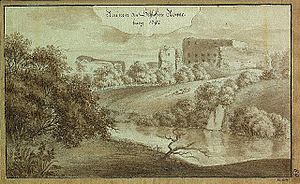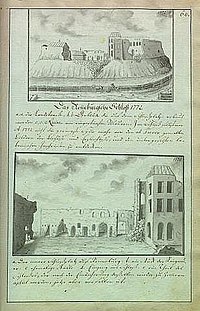Ronneburg Castle (Latvia)
| Ronneburg Castle | ||
|---|---|---|
|
Wall of the convent house |
||
| Alternative name (s): | Raunas viduslaiku pils | |
| Castle type : | Hilltop castle | |
| Conservation status: | ruin | |
| Place: | Rauna | |
| Geographical location | 57 ° 19 '56.7 " N , 25 ° 36' 37.2" E | |
|
|
||
The Ronneburg Castle ( Latvian Raunas viduslaiku pils ) is the ruin of a hilltop castle in the village of Rauna (German Baltic Ronneburg ) in the district of Cēsis (Wenden) , Latvia . The castle was the residence of the bishops of Riga in the southeastern, so-called Latvian part of the archdiocese, while Lemsal Castle was the residence in the so-called Livon , northwestern, part of the archdiocese.
history
In connection with the establishment of the Riga Archdiocese by the Pope in 1251 and the arrival of Albert Suerbeer as Archbishop in 1253, the construction of three administrative centers of the diocese began, including Ronneburg, which was on the important trade route to Pleskau . The castle was probably built by Archbishop Suerbeer in the winter months of 1262. According to another opinion, the next Archbishop Johannes von Lune started construction, as inscriptions on the castle show that construction work was carried out during his reign as John I in the years 1273 to 1284.
Ronneburg Castle was first mentioned in a letter from Archbishop Johann IV. Von Zinten on December 9, 1381 as "Castro Nostro Ronneborgh". According to Armin Tuulse, the castle was built in the mid-14th century. The name of the castle is possibly derived from the Raunais brook .
From 1405 to 1418 the archbishopric was pledged together with Ronneburg. In 1418, the archbishops received the now neglected castles back and relocated the seat of the diocese to Ronneburg. In 1479 the castle was again conquered by the Livonian Order .
Archbishop Silvester Stodewescher lived on Ronneburg from 1448 to 1479 . During the so-called “Pfaffen-Krieg” troops of Order Master Bernd von der Borch invaded the archdiocese in early 1479 and conquered several castles, including Treyden , Lemsal , Ronneburg and Smilten , within two weeks “without hitting a sword or a gunshot” .
Ronneburg Castle had one of the first libraries in Latvia, as the Archbishop collected holdings in the Kokenhusen and Ronneburg castles.
In the 15th and 16th centuries, especially under Archbishop Jasper Linde , the Ronneburg was reinforced by large round towers designed to protect against firearms. During the Livonian War , the castle was first occupied by the Teutonic Order in 1556 , then from 1577 to 1582 by Russian troops. After the castle finally became the property of Poland-Lithuania, it lost its importance compared to Wenden Castle . The castle was destroyed in the Second Northern War between Poland, Sweden and Lithuania. During the Swedish occupation, the fortifications were razed in 1683 and fell into disrepair.
architecture
The castle is on a high ridge. The walls of the main building, 47.5 m long and 35.7 m wide, enclosed a courtyard. The building complex formed a long square, the east side of which has remained undeveloped, with a two-bay chapel at the east end of the south wing . There were two remterers in the west wing and the dormitory in the north wing . The three semicircular towers added in the 15th and 16th centuries also protected the upper castle from the forecourt. One of the towers, built under Jasper Linde , was named "the long Kaspar". Another defensive element were ponds, which were created around the castle from the south and east and served the function of a moat. An unconventional solution was the main entrance to the castle, which partly ran underground in the outer eastern wall ring.
Current condition
Large parts of the wall of the inner castle have been preserved. From the outer ward only small stone relics can be seen. A round substructure with a diameter of 7 m has been preserved from the “long Kaspar”.
Individual evidence
- ↑ a b Armin Tuulse: The castles in Estonia and Latvia (= negotiations of the Estonian learned society . Volume 33 ). Õpetatud Eesti Seltsi Toimetused, S. 201-202 ( PDF ).
- ^ AF Büsching: Great description of the earth . S. 172 ( link ).
- ^ The von Rönne family in the Baltic States. Retrieved April 15, 2019 .
- ^ Heinrich von Hagemeister: Materials for a history of the country estates of Livonia . tape 1 . Riga 1836, p. 189 ( link ).
- ↑ Замок Рауна (Ронненбург - Ronnenburg). Retrieved April 16, 2019 .
- ^ A b c Karl Woldemar von Löwis of Menar: Burgenlexikon für Alt-Livland . Walters and Rapa, Riga 1922, p. 86-87 ( digitized version ).
- ↑ August W. Hupel: The current constitution of the Rigische and Revalschen Lieutenancy . S. 349 ( link ).
- ↑ Gustav von Bergmann: History of Livonia, designed in the Bossuet style . 1776 ( online ).
- ^ Bernhard Fabian, Olms-Weidmann: Handbook of German historical book collections in Europe: an overview of collections in selected libraries . tape 7 ( Libraries in Latvia ).
- ↑ a b Rauna - bishop's castle Ronneburg. Retrieved April 9, 2019 .
- ↑ Knight Brothers in the Livonian branch of the Teutonic Order. Cologne: Böhlau, 1993. No. 268 (lk 239)
- ↑ a b Ieva Ose: Some knowledge about the residences of the Archbishops of Riga from the end of the 15th to the middle of the 16th century . In: Castella Mare Baltici . tape XII ( academia.org ).



